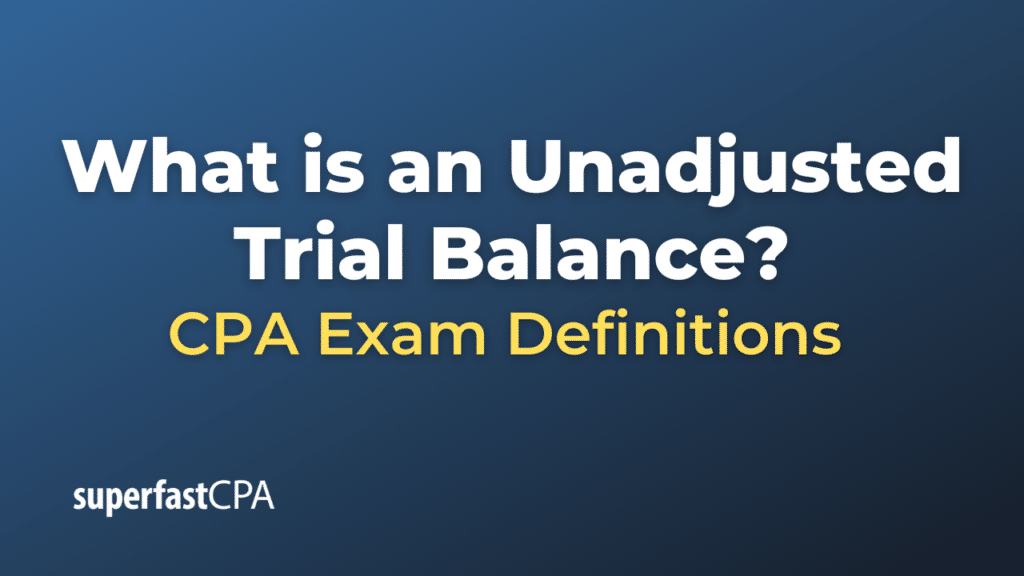Unadjusted Trial Balance
An “Unadjusted Trial Balance” is a list of all the general ledger accounts and their respective balances at a specific point in time before any adjustments are made for year-end or period-end adjusting entries. This report provides a snapshot of the company’s accounts at a raw level, displaying the balances without considering necessary adjustments.
The main purpose of the unadjusted trial balance is to ensure that the total debits equal the total credits. It’s a preliminary step, and if there are discrepancies, it indicates there might be errors in the journal entries or ledger accounts.
Here’s a simplified structure of how it looks:
Unadjusted Trial Balance as of [Date]
| Account Name | Debit ($) | Credit ($) |
|---|---|---|
| Cash | 20,000 | |
| Accounts Receivable | 10,000 | |
| Supplies | 5,000 | |
| Equipment | 50,000 | |
| Accounts Payable | 10,000 | |
| Unearned Revenue | 5,000 | |
| Owner’s Equity | 50,000 | |
| Revenues | 20,000 |
| Expenses | 15,000 | |
|---|---|---|
| Totals | 100,000 | 100,000 |
In the above table:
- The total of debit balances ($100,000) equals the total of credit balances ($100,000).
- No adjustments have been made yet for expenses that might have been incurred but not yet recorded or for revenues that have been earned but not yet recorded.
After the unadjusted trial balance, accountants typically prepare adjusting entries to account for items like accrued expenses, accrued revenues, prepaid expenses that are now used up, and unearned revenue that has now been earned. Following these adjustments, an “Adjusted Trial Balance” is prepared, which serves as the basis for preparing the financial statements of the entity.
Example of an Unadjusted Trial Balance
Let’s walk through an example of preparing an unadjusted trial balance for a fictional company called “Green Leaf Landscaping.”
Background:
Green Leaf Landscaping started its operations recently. By the end of the first month, the company’s accountant wants to ensure that debits and credits are balanced, so an unadjusted trial balance is prepared.
Here’s a summarized version of Green Leaf’s ledger accounts:
- Cash: $10,000 (Debit balance)
- Accounts Receivable: $2,000 (Debit balance)
- Supplies: $500 (Debit balance)
- Equipment: $5,000 (Debit balance)
- Accounts Payable: $1,500 (Credit balance)
- Owner’s Equity (Owner’s Capital): $15,000 (Credit balance)
- Service Revenue: $3,500 (Credit balance)
- Salaries Expense: $1,000 (Debit balance)
- Rent Expense: $500 (Debit balance)
Unadjusted Trial Balance for Green Leaf Landscaping (Month-End)
| Account Name | Debit ($) | Credit ($) |
|---|---|---|
| Cash | 10,000 | |
| Accounts Receivable | 2,000 | |
| Supplies | 500 | |
| Equipment | 5,000 | |
| Accounts Payable | 1,500 | |
| Owner’s Equity | 15,000 | |
| Service Revenue | 3,500 | |
| Salaries Expense | 1,000 |
| Rent Expense | 500 | |
|---|---|---|
| Totals | 19,000 | 20,000 |
Oh no! The debits and credits don’t match! There’s a discrepancy of $1,000. This means there might be an error in the ledger accounts or in the postings from the journal entries to the ledger. The accountant will need to trace and find the discrepancy to ensure the debits and credits are equal.
Note: In real life, any discrepancies would need to be resolved before proceeding further. Adjustments would then be made after the balances are correctly matched.












